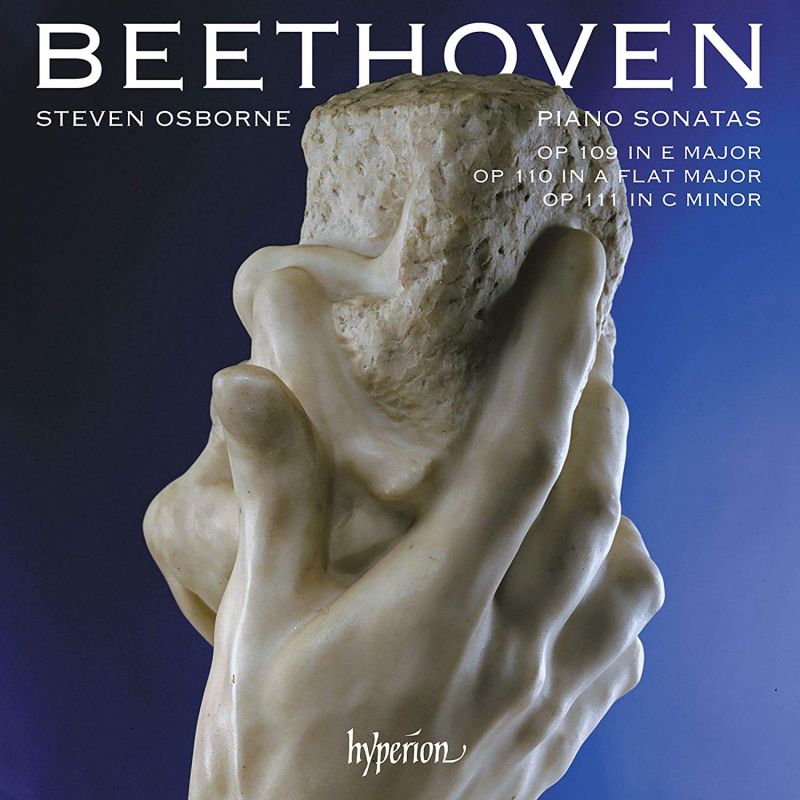BEETHOVEN Piano Sonatas Opp 109-111 (Steven Osborne)
View record and artist detailsRecord and Artist Details
Composer or Director: Ludwig van Beethoven
Genre:
Instrumental
Label: Hyperion
Magazine Review Date: 05/2019
Media Format: CD or Download
Media Runtime: 64
Mastering:
DDD
Catalogue Number: CDA68219

Tracks:
| Composition | Artist Credit |
|---|---|
| Sonata for Piano No. 30 |
Ludwig van Beethoven, Composer
Ludwig van Beethoven, Composer Steven Osborne, Piano |
| Sonata for Piano No. 31 |
Ludwig van Beethoven, Composer
Ludwig van Beethoven, Composer Steven Osborne, Piano |
| Sonata for Piano No. 32 |
Ludwig van Beethoven, Composer
Ludwig van Beethoven, Composer Steven Osborne, Piano |
Author: Harriet Smith
When I was doing a Building a Library on Op 109 last year for BBC Radio 3, I was looking for a combination of wonder and fantasy that didn’t tip over into late Romanticism in the first movement, fearsome firepower without edge in the Prestissimo and a Classicism to the theme of the finale’s variations. And that is exactly what we get here. Sample Osborne’s way with the theme of the finale: it has an outward simplicity from which the variations can grow, yet listen more closely and you’ll detect the endlessly varied colourings and subtle changes of dynamics and phrasing, making the repeats truly developmental. Impressive too is the way the variations unfold with complete inevitability: from the octave right-hand leap in the first, which is given without mannerism, via the perfect accord between the hands in the dotted articulation of the second, which contrasts beautifully with the more extended line of the third. The fugue has an almost gleeful quality to it and the closing minutes, in which Beethoven envelops the line in trills, is very well gauged, leading to a reprise of the finale’s opening theme that is moving in its guilelessness. Altogether this performance is on a par with Richard Goode’s.
What is particularly winning about this new set is the way Osborne occupies the very different world of each sonata with equal conviction, which is by no means always the case, even with indubitably great pianists. Uchida, for instance, convinces me far more in Op 109 than in Op 111. And last month I found Yevgeny Sudbin better in Op 110 than in the last sonata. He, however, completely pales alongside Osborne in Op 110. Just a few moments comparing the two in the second movement demonstrate the point: whereas Sudbin had a tendency for agogic distortions, Osborne has a fire-and-brimstone intensity to his playing. Even Levit, whom I much admire in all three sonatas, pales by comparison here. Lewis finds a similar sense of the extremes of the music, though he doesn’t relish the clipped fortissimo writing to quite the same degree. And in the Adagio ma non troppo momentum never sags, even though the sense of desolation is manifest. Here, and throughout, there’s a sense of Osborne simply letting the music sound, rather than imposing himself on it. The fugue starts unobtrusively and the outbursts of ire have tremendous power. Levit is similarly dramatic here, his accompanying figuration a little less defined – choice is really down to taste.
Anyone who has heard Osborne’s visceral recording of the Hammerklavier won’t be surprised to find a similar combination of muscularity and extreme delicacy in the opening movement of the last sonata. But again there’s a sense of an underlying Classicism; and, after a Maestoso introduction full of sharp edges, there’s an absolute inevitability and clarity to the Allegro con brio with plenty of appassionato thrown in. His pedalling is a masterpiece of subtlety and I like the clipped chords, which are angry but laced at times with a kind of grim pleasure. The ferocity with which he maintains and builds momentum from 5'56" is darkly thrilling. And the ending has a quietude that makes what comes next sound entirely inevitable.
The theme of the Arietta has, like that of the finale of Op 109, an innate sense of stillness and Osborne is every bit as compelling as Goode in the way the variations unfold, growing naturally so that the duetting hands sound as one in the second, while the boogie-woogie third has plenty of character without sounding out of place as it can do; the return to quiet of the fourth has a whispered inwardness. The trilling in the closing couple of minutes has its own range of emotion, from fragility to a sense of peace, and with the ending comes the requisite sense of the sublime. In this Osborne is assisted by a very natural recorded sound.
Steven Osborne has made many outstanding recordings but this is certainly among his finest. A magnificent achievement.
Discover the world's largest classical music catalogue with Presto Music.

Gramophone Digital Club
- Digital Edition
- Digital Archive
- Reviews Database
- Full website access
From £8.75 / month
Subscribe
Gramophone Full Club
- Print Edition
- Digital Edition
- Digital Archive
- Reviews Database
- Full website access
From £11.00 / month
Subscribe
If you are a library, university or other organisation that would be interested in an institutional subscription to Gramophone please click here for further information.




